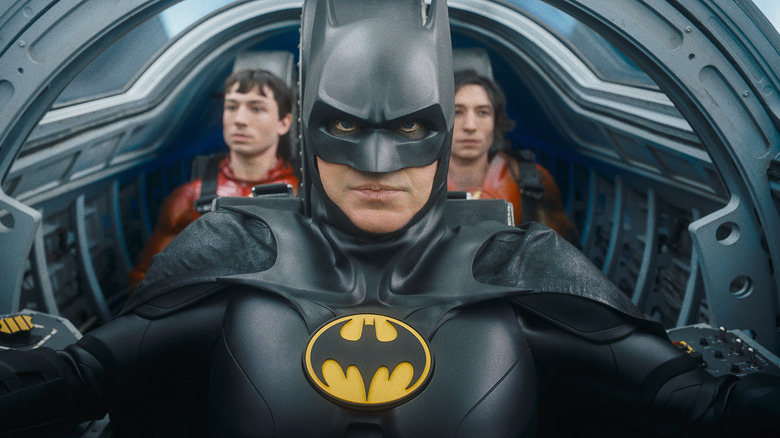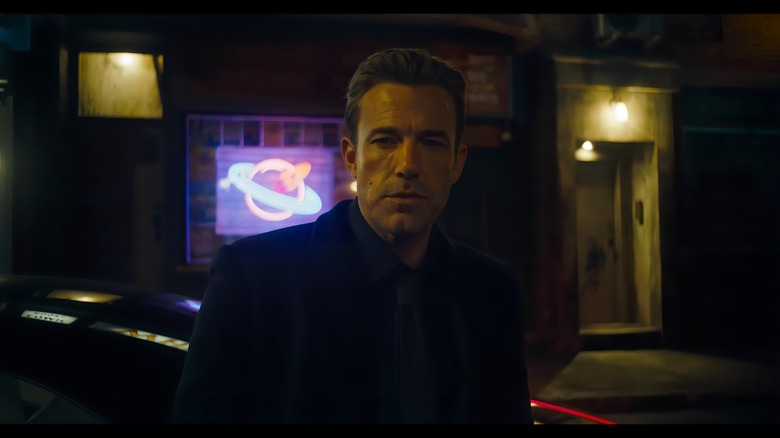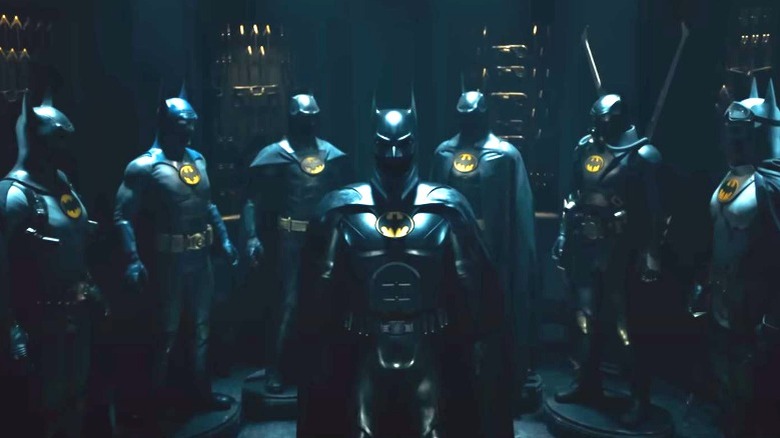How The Flash Solves The DCU's Glaring Batman Problem
This article contains spoilers for "The Flash"
How many Batmen can fit in the DCU? "The Flash" seems to think that the answer is "all of them." Apart from both Ben Affleck's and Michael Keaton's versions of the character playing prominent roles in the movie, the big twist in the ending is the return of George Clooney's "Batman & Robin"-era Bruce Wayne. What's more, we get quick glimpses of various multiversal superheroes in the movie's final act, and since Adam West's 1960s Batman is among them, it's probably safe to say that every single Batman exists in some corner of the multiverse — possibly even the supposedly non-DCU Robert Pattinson version.
With this revelation, it seems that the DCU suddenly has an infinite amount of Batman potential at its disposal. While this may seem like a bit of a ridiculous notion for a character who's notorious for being rebooted and recast every few years even without any alternate-timeline shenanigans, "The Flash's" big multiverse twist actually ends up solving the DCU's multiple-Batmen issue ... simply by giving the movie universe the option to ignore it altogether.
The bats are everywhere, but The Flash makes it all right
Batman is a huge part of "The Flash" — so big, in fact, that Barry Allen (Ezra Miller) even spends the movie's post-credits scene talking about the Caped Crusader's multiversal nature. This discussion between Barry and Aquaman (Jason Momoa) is just one of the film's many moments that explore alternate-universe Bruce Waynes and remind the viewer just how deeply different they all are.
The genius of "The Flash" is that it manages to introduce the idea that "more Batmen" is a good idea instead of a deeply confusing one. With its future- and past-altering "spaghetti" take on the Multiverse, the movie essentially pats the viewer on the back and tells them, "Buckle up — after this, anything can happen." Since it so heavily uses the character of Batman to illustrate this point, "The Flash" is essentially both a movie about Barry Allen's time-bending adventures and a two-and-a-half-hour learning video about all the reasons why there can be tons of Batmen in the future. As a result, the DCU now has an umbrella explanation for whenever it feels like bringing a new Batman or three in the mix: just invoke time-traveling shenanigans and alternate timelines.
Oh, and as a bonus, the movie finally allows Affleck (who's been hovering by the door for what seems like an eternity) a graceful exit from the DC movie universe by casually writing him out of existence and replacing him with George Clooney. OK, a comparatively graceful exit.
The DCU now has free reign to use as many Batmen as it wants
"The Flash's" attempts to indoctrinate the viewers into the concept of multiple Batmen being awesome aren't exactly subtle, but it's hard to walk out of the movie without feeling excited about the opportunities this provides to the DCU. Granted, the movies have always done more or less what they like with Batman, but now, they can really go all out. Will James Gunn retain George Clooney's Bruce Wayne as the main timeline Batman, and the lead character in "Batman: The Brave and the Bold?" Was his appearance just a clever cameo, and yet another Batman is about to enter the DCU? How about multiple new DCU Batmen, allowing Gunn and company to explore all sorts of cool Elseworlds stories? Was "The Flash" really Affleck's final appearance as Batman? Could Pattinson's "The Batman" version of the character turn up at some point due to timeline shenanigans? Seems unlikely, but hey — so did Clooney's return before "The Flash."
As DC's long-serving flagship character, Batman has had many comic book incarnations over the years — yet, up until very recently, the movies have been confined to a single vision of the character at a time. Now, "The Flash" has given the DCU free reign to explore Batman's various aspects as it sees fit, and frankly? Batman's big-screen future has rarely seemed more exciting.


